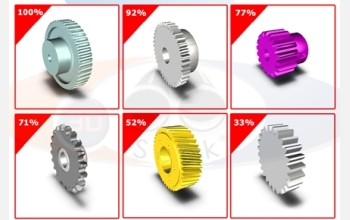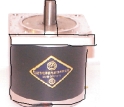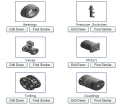|

Press Release 06-035
Doodle Search

New software can hunt through online catalogs using only a sketch
February 23, 2006
Working with support from the National Science Foundation's Small Business Innovation Research (SBIR) program, Imaginestics, a company located in West Lafayette, Ind., has created 3D-Seek: a new kind of search engine that lets users find items in an online catalog without ever needing to know the items' names, part numbers or keywords.
Thanks to a major advance in practical pattern recognition, all the user needs is a freehand sketch--a doodle.
The Purdue Research Park-based company developed 3D-Seek and its associated catalog mainly for manufacturing firms, which are constantly looking for hinges, bolts, conveyor belts, motors and a host of other products. For those firms, notes Errol Arkilic, the NSF officer overseeing the SBIR awards, "this search engine can help find the proverbial needle in the haystack. By allowing manufacturers to re-deploy and re-purpose parts from existing catalogs, the tool can make it easier for businesses to design complex mechanical systems."
Eventually, however, the basic search engine could prove equally useful for ordinary shoppers: instead of having to go to the hardware store lugging, say, a specific plumbing joint, a customer could just sketch what he or she needed to find an exact match.
The 3D-Seek software was built on top of technology created by Karthik Ramani and his colleagues at the NSF-supported Purdue Research and Education Center for Information Systems in Engineering (PRECISE) at Purdue University. Ramani, who is an NSF CAREER Awardee, the director of PRECISE and the chief scientist of Imaginestics, had led the way toward search algorithms that ranked among the world's fastest for a certain application: comparing the computer-aided design files and other 3-D images that are ubiquitous in industry.
From there, further collaboration between university and company researchers resulted in a system that required only critical shape characteristics, not entire image files. This allowed even faster search speeds and protected the proprietary information held by parts suppliers loading their products to the online database. And as a bonus, the refined search could now glean important information from quick sketches, a favorite means of communication for engineers and designers.
The public can try the freehand-search online at the 3D-Seek portal.
"In order to make such a search engine commercially viable we had to overcome the challenge of matching something as rudimentary as a doodle to a 3-D object - in seconds," said Nainesh Rathod, co-founder and President of Imaginestics. "This is important, as Web users have become accustomed to retrieving information instantaneously. Our shape-search engine processes data that are far more complex then those handled by the leading Internet search engines, and yet still finds results quickly."
While researchers have been working for several years on software that can compare industry-standard 3-D image files to each other, the new method is faster than most and permits search "terms" that are far outside the norm. With the new tool, users can find in seconds what once took weeks of warehouse searches or even a complete part redesign.
"It's the difference between describing a part over the phone and seeing it in person," added Rathod. "You can look at it visually instead of explaining it in words."
The 3D-Seek catalog currently contains more than 6,000 parts and continues to grow as suppliers manually upload their files or as the system's i-crawler web spider discovers parts online. A related technology, i-prowler, hunts for image files on a user's computer and merges them with either the online database or an internal company catalog - critical for large companies that may not have simple mechanisms to search internal inventories.
Even global corporations can have difficulty tracking supplies internally. According to Rathod, a Fortune 100 manufacturer recently estimated that lack of a proper search technology resulted in duplicate purchases for 10 to 16 percent of parts.
One reason is that factories creating the same product, yet located continents apart, will go to different suppliers for the same component. Those suppliers may have to independently engineer the components from scratch, which can be costly. With an easily searchable company-wide database, even metric conversion would not stand in the way of a part search.
-NSF-

Media Contacts
Joshua A. Chamot, NSF (703) 292-7730 jchamot@nsf.gov
Jeanine S. Phipps, Purdue University and Purdue Research Foundation (765) 494-0748 jsphipps@prf.org
Program Contacts
Errol B. Arkilic, NSF (703) 292-8095 earkilic@nsf.gov
Alex Schwarzkopf, NSF (703) 292-5359 aschwarz@nsf.gov
Principal Investigators
Nainesh Rathod, Imaginestics (765) 464-1700 nainesh.rathod@imaginestics.com
Related Websites
3-D Seek portal: http://www.3d-seek.com
PRECISE Web site: http://tools.ecn.purdue.edu/~cise/

The National Science Foundation (NSF) is an independent federal agency that supports fundamental research and education across all fields of science and engineering. In fiscal year (FY) 2009, its budget is $9.5 billion, which includes $3.0 billion provided through the American Recovery and Reinvestment Act. NSF funds reach all 50 states through grants to over 1,900 universities and institutions. Each year, NSF receives about 44,400 competitive requests for funding, and makes over 11,500 new funding awards. NSF also awards over $400 million in professional and service contracts yearly.
 Get News Updates by Email Get News Updates by Email
Useful NSF Web Sites:
NSF Home Page: http://www.nsf.gov
NSF News: http://www.nsf.gov/news/
For the News Media: http://www.nsf.gov/news/newsroom.jsp
Science and Engineering Statistics: http://www.nsf.gov/statistics/
Awards Searches: http://www.nsf.gov/awardsearch/
| 






